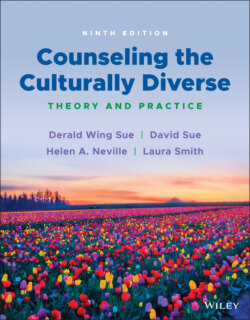Читать книгу Counseling the Culturally Diverse - Laura Smith L. - Страница 29
DID YOU KNOW?
ОглавлениеTalking about race, gender, and sexual orientation with culturally diverse clients often result in extreme tension and anxiety. Discomfort in racial dialogues may make the helping professional's verbalizations tentative, obtuse, abstract, and filled with nonsensical utterances. In an attempt to avoid being seen as racist or sexist, the therapist may reveal difficulties in articulation, barely audible speech, voice constriction, trembling voice, stammering and stuttering, and mispronunciation of common words. This phenomenon has been labeled rhetorical incoherence. Ironically, the attempt not to appear biased actually has the opposite effect: the counselor may appear more racist!
Source: Bolgatz (2005) and Bonilla‐Silva (2006).
These thoughts, feelings, and concerns blocked participants from fully participating in learning and discussing diversity issues, because they became so concerned about themselves (turning inward) that they could not freely be open and listen to the messages being communicated by socially devalued group members. Indeed, their whole goal seemed to be to ward off the messages and meanings being communicated to them, which challenged their worldviews, and themselves as racial beings, and highlighted their potential roles as oppressors.
For those who are able to listen to stories about racial and other forms of oppression, some allow their anxiety and fear to immobilize them: “I think sometimes I'm afraid to say things because I don't want to offend people, and so I just decide … to sit and be quiet” (Linder, 2015, p. 545). One's fear of appearing racist or offensive thus undermines learning because one remains silent in discussion and allows others to do the difficult work of self‐exploration; oftentimes, the brunt of the work is then unduly put on the shoulders of the People of Color or other marginalized group members in the class.
